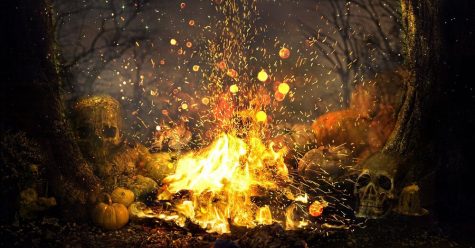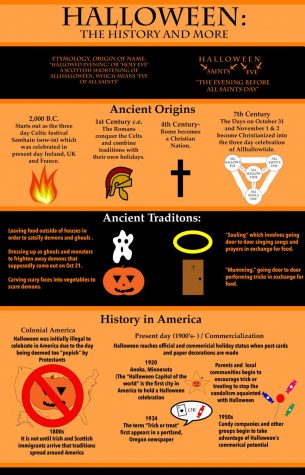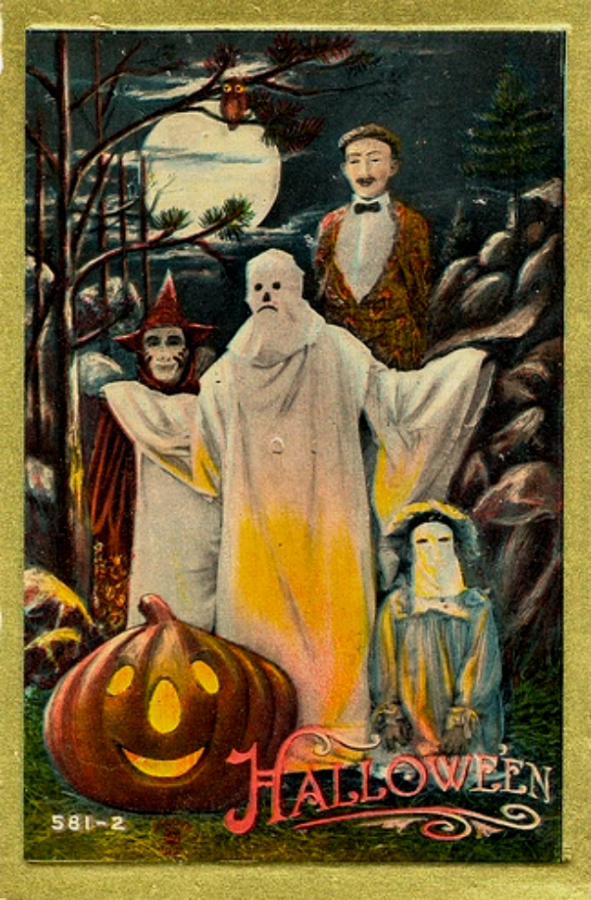Origins of Halloween
In modern times, Halloween is flooded with the smell of candy corn so sweet it makes your teeth shake or can be glorified for the adrenaline so high you won’t be able to sleep the night before. How did Halloween get to be a time of neon wigs and animal costumes, a time where children walk from door to door asking their neighbors for candy?
To learn how Halloween evolved to become the large festival it is in the modern world, we have to go back about 2,000 years. The Celtic festival of Samhain, celebrated in Ireland, Northern France, and the United Kingdom, became a largely celebrated tradition where civilians lit fires and dressed up to ward off ghosts and evil spirits. As the summer season and harvest came to an end, the depressing winter follows closely. The short days and cold winter were associated with death, so during the transition from summer to winter, the line between dead and alive is blurred as they believed the dead can come to life as ghosts. Celtics called the celebration All Hallow’s Eve, celebrating the dead and warding off the evil spirits as the dead came to the present.
 All Hallows’ Eve is the ‘eve’ of the next day, dedicated to honoring saints. It became a religious holiday, later called Halloween. The Celtic priest called druids were believed to predict the future on All Hallows Eve. During the celebration, Celtics would create bonfires and perform ceremonies, such as the burning of crops and animals.
All Hallows’ Eve is the ‘eve’ of the next day, dedicated to honoring saints. It became a religious holiday, later called Halloween. The Celtic priest called druids were believed to predict the future on All Hallows Eve. During the celebration, Celtics would create bonfires and perform ceremonies, such as the burning of crops and animals.
The Romans later conquered Celtics, and their respective celebrations merged together and grew to become a larger festival. One of the resulting celebrations was Feralia, the celebration of the dead. Modern-day Halloween borrows traditions from the Roman celebration of Feralia which influenced the ideas of ghosts. Another observance was Honor of Pomona, Pomona is the Goddess of fruit, this could be the start of the bobbing for apples tradition.
 Halloween spread to the Americas in the 1800s when the Irish migrated to the Americas to flee from the potato famine. Immigrants helped popularize Halloween in America, starting an ongoing tradition. Trick-or-treat started in the Middle Ages with a tradition called “mumming.” The impoverished people of the town would dress up in animal skin and fur then promise to pray for deceased residence’s family members who once lived in that home. In return, the homeowner would give those who agreed to pray for those who had passed away a pastry called a soul cake. The idea influenced the trick-or-treat tradition. In Scotland and Ireland, some people would dress in animal fur and recite poems or do tasks in order to receive treats. In other countries, citizens would demand treats. Else, they perform a trick, hence the name ‘trick-or-treat’.
Halloween spread to the Americas in the 1800s when the Irish migrated to the Americas to flee from the potato famine. Immigrants helped popularize Halloween in America, starting an ongoing tradition. Trick-or-treat started in the Middle Ages with a tradition called “mumming.” The impoverished people of the town would dress up in animal skin and fur then promise to pray for deceased residence’s family members who once lived in that home. In return, the homeowner would give those who agreed to pray for those who had passed away a pastry called a soul cake. The idea influenced the trick-or-treat tradition. In Scotland and Ireland, some people would dress in animal fur and recite poems or do tasks in order to receive treats. In other countries, citizens would demand treats. Else, they perform a trick, hence the name ‘trick-or-treat’.
Today, Halloween is no longer religious nor the festival it used to in Roman traditions. We think of Halloween as an amusing celebration with activities such as carving pumpkins and dressing up; however, during the Roman Empire, it was a religious day to celebrate the deceased loved ones. Nonetheless, there remain elements and traditions from thousands of years ago that have endured to the present. Costumes, bobbing for apples, and trick or treating remains a prominent tradition in modern-day Halloween that Americans celebrate with great enthusiasm. However, Halloween is not solely an amusing event to dress up and receive candy but a remembrance of history while keeping the tradition of those who shaped the world we live in today alive.

Sarita Manocha, a senior, has found a passion for writing throughout her years at Keystone. In Keynote Sarita spreads awareness and brings to attention...

